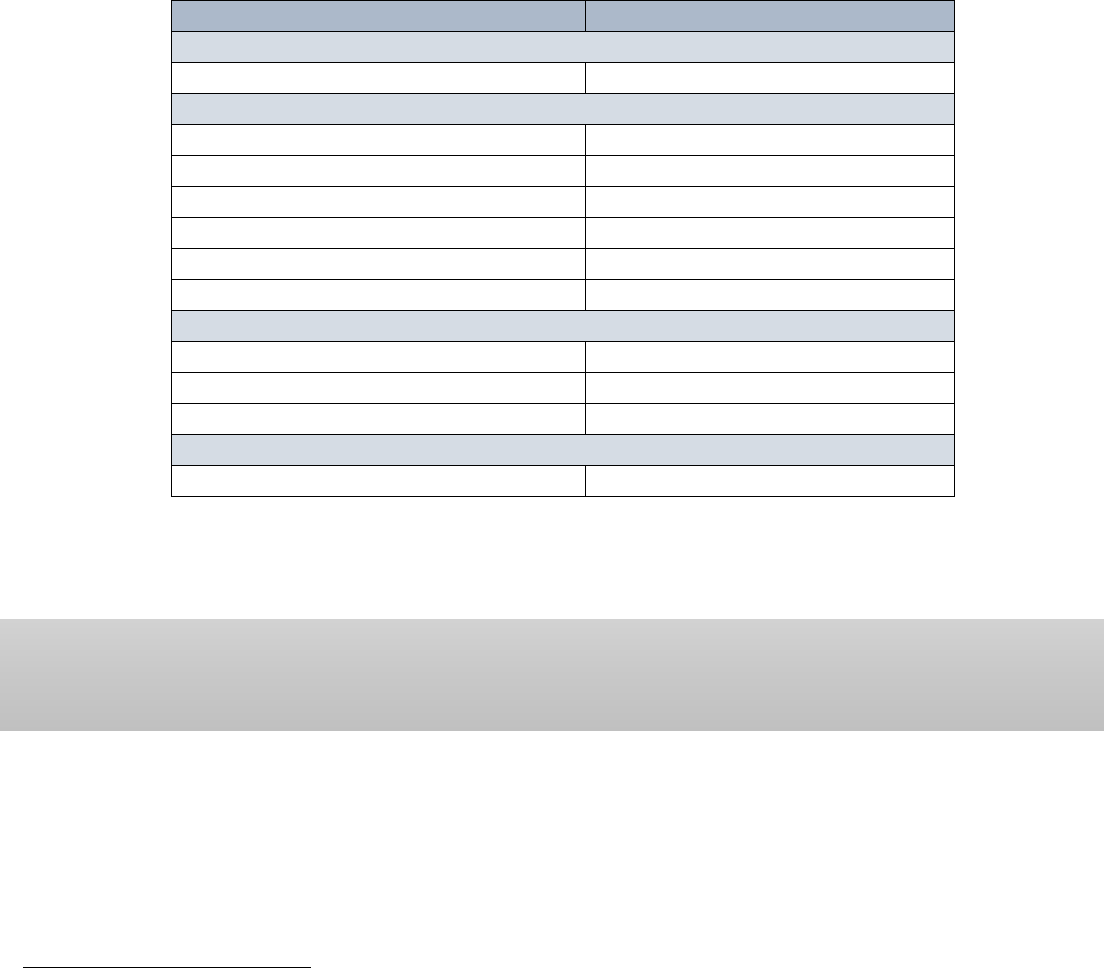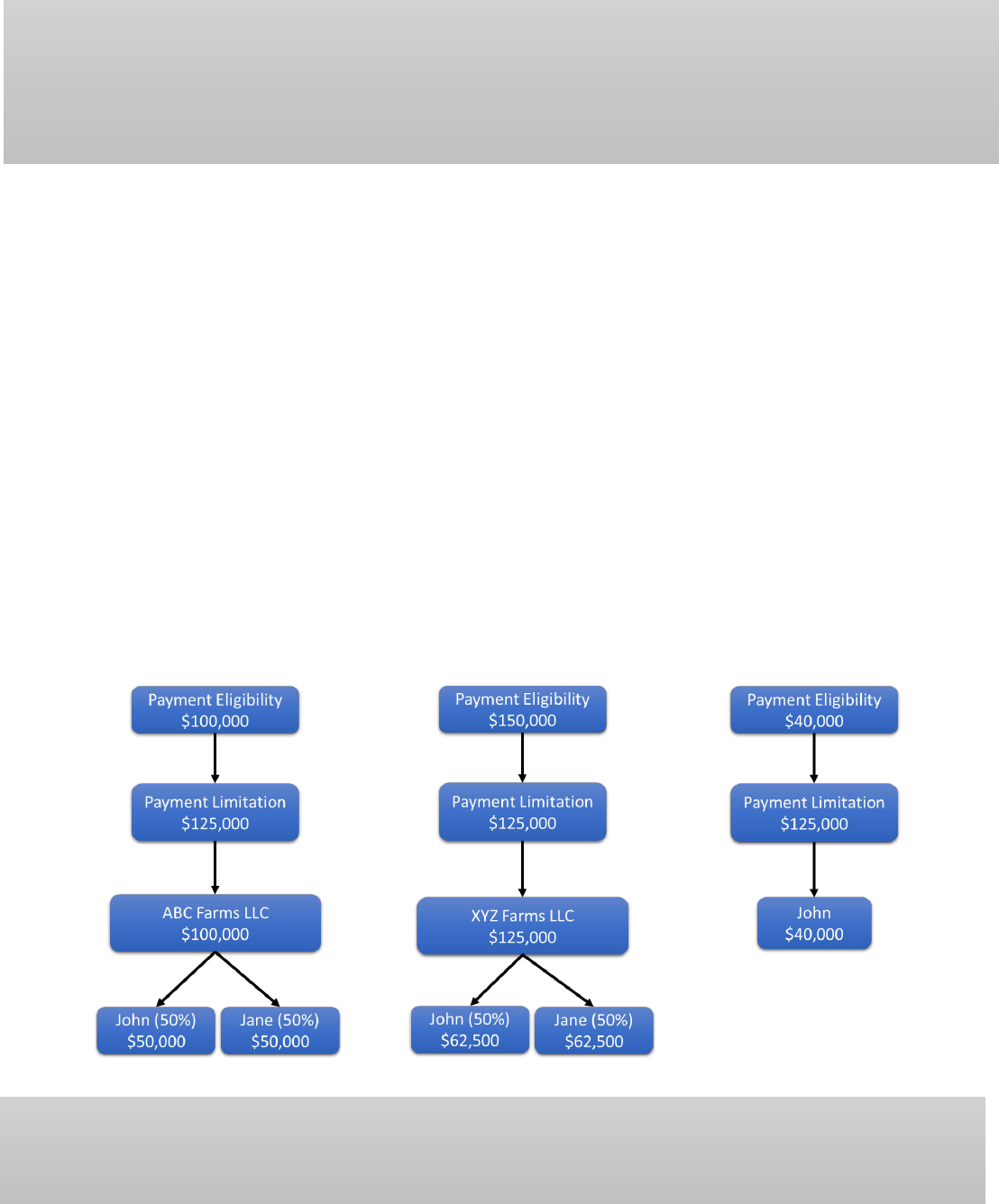
Farm Service Agency Programs and Business Entities
Robert Moore Zachary Ishee
Attorney and Research Specialist Law Fellow
OSU Agricultural & Resource Law Program National Agricultural Law Center
The Farm Service Agency (FSA) is an agency within the United States Department of Agriculture
(USDA) that supports farms and farming communities with disaster relief, conservation, commodity
price guarantees, and loan programs through state and county offices. Each FSA program has its
own rules and requirements for eligibility, but the business entity a producer chooses can have
significant impacts on program eligibility and payments. This bulletin informs producers of the
impacts different business entities can have when utilizing FSA programs.
FSA definition of business entities
The FSA has a unique manner of defining business entities for FSA program purposes. Two
categories of business entities exist in FSA: “joint operation” and “legal entity” A “joint operation” is a
general partnership or joint venture whose members are jointly and severally liable for the obligations
of the business--a general partnership is an entity comprised of two or more persons formed under
state law subject to a formalized agreement, and a joint venture is a general partnership without a
formalized agreement. A “legal entity” for FSA purposes is any entity organized under state law with
liability protection for its owners, and includes corporations, limited liability companies(LLC), and
limited partnerships. A legal entity can have any number of owners.

farmoffice.osu.edu 2
FSA program rules
There are two categories of FSA program rules. “Payment limitation rules” cap the amount of money
a person or entity can receive from a particular program. “Payment eligibility rules” determine
whether an individual or business entity can receive payment at all. Some programs have payment
limitation rules, some have payment eligibility rules, and some programs have both. Table 1 shows
FSA programs that have payment limitation and payment eligibility rules, further explained in this
bulletin.
Table 1. Payment Limitation and Payment Eligibility Rules for FSA Programs
FSA Program
Payment
Limitation
Payment Eligibility
Actively engaged in
farming requirement
AGI limit
Conservation programs
CRP
1
Yes
Yes
Yes
CRP
2
Yes
No
Yes
ECP
No
No
Yes
EFRP
No
No
Yes
ACEP (NRCS)
Yes
No
Yes
AWEP (NRCS)
Yes
No
Yes
CBWI (NRCS)
Yes
No
Yes
EQIP (NRCS)
Yes
No
Yes
CSP (NRCS)
Yes
No
Yes
RCPP (NRCS)
Yes
No
Yes
WHIP (NRCS)
Yes
No
Yes
Commodity programs
ARC and PLC
Yes
Yes
Yes
Disaster assistance programs
ELAP
No
No
Yes
LFP
No
No
Yes
LIP
No
No
Yes
NAP
No
No
Yes
TAP
No
No
Yes
Price support programs
MAL
No
No
No
LDP
No
No
Yes
MLG
No
No
Yes
DMC
No
No
No
Other programs
AMA
Yes
No
Yes
1
CRP contracts approved before October 1, 2008, are subject to 1-PL provisions, including permitted entity provisions.
2
4-PL, 5-PL and 6-PL.

farmoffice.osu.edu 3
Payment limitation rules
Payment limitation rules restrict the amount an individual or legal entity can receive from an FSA
program. Table 2 shows the payment limitations for various FSA programs.
Table 2. Program Payment Limitation Amounts
Program and Payment Type
Annual $ Limitation through 2023
Commodity and price support programs
ARC and PLC Payments
125,000
Conservation programs
AMA
50,000
3
CRP Annual Rent and Incentive
50,000
4
CSP
200,000
5
ECP (Per Disaster)
500,000
EFRP (Per Disaster)
500,000
EQIP
450,000
6
Disaster assistance programs
LFP
125,000
NAP (Catastrophic Coverage)
125,000
NAP (Buy-up Coverage)
125,000/300,000
7
Other programs
TAAF
10,000
Payment limitations apply to each program separately. That is, reaching the payment limitation on
one program does not affect the payment limitation of another program, as Example 1 illustrates.
Example 1. John is the sole proprietor of a grain farm. He is eligible for ARC payments of $200,000.
However, due to payment limitation rules, he can only receive $125,000 of ARC payments. John can
also receive up to $50,000 of CRP payments without affecting his ARC payment amount.
FSA payment limitations and different business entities
FSA considers a legal entity to be a single person for payment limitation analysis. The legal entity is
limited to one payment limitation per program, regardless of the number of owners in the entity. A
joint operation, on the other hand, is eligible to receive as many payment limitations per program as
3
The $50,000 limitation is the total limit that a participant may receive under the AMA program in any FY.
4
CRP contracts approved before October 1, 2008, may exceed the limitation, subject to payment limitation rules in effect on the date
of contract approval.
5
The $200,000 limitation is the total limit under all CSP contracts entered into subsequent to the enactment of the 2014 Farm Bill
during FY’s 2014 through 2018 and of the 2018 Farm Bill during FY’s 2019 through 2023.
6
The $450,000 limitation is the total limit under all EQIP contracts entered into subsequent to the enactment of the 2014 Farm Bill
during FY’s 2014 through 2018 and of the 2018 Farm Bill during FY’s 2019 through 2023.
7
The 2018 Farm Bill provides a separate maximum limitation of $125,000 on NAP payments for losses to crops with catastrophic
coverage and a $300,000 maximum limitation on NAP payments for losses to crops with buy-up coverage.

farmoffice.osu.edu 4
there are owners in the operation.
8
The result of this rule is that a large, multiple-owner farm
operation may want to consider organizing as a general partnership to increase the number of
payment limitations the operation can use under the ARC and PLC programs. Consider the following:
Example 2. John and Jane are equal owners of an LLC that operates as a large grain farm. They
could receive $250,000 of ARC payments based on the number of acres they farm. However,
because the LLC is a legal entity, it is only eligible for one ARC payment limitation of $125,000. John
and Jane will receive a total of $125,000 in ARC payments.
Example 3. Same scenario as Example 2, except John and Jane operate as a general partnership.
The partnership is eligible for two payment limitations, one for each partner. John and Jane can
receive a total of $250,000 in ARC payments.
Reducing liability risk while increasing payment limitations
While using a general partnership can increase FSA payment limitations, it can also bring additional
liability exposure for its partners. For further explanation of liability characteristics of different
entities, see our law bulletin in this series on Using Business Entities to Manage Farm Liability Risk.
There is a strategy, however, that can limit the increased liability risk of a general partnership. If each
partner in the general partnership is organized as a single member LLC, the LLC would limit the
partnership liability of its owner to the extent of the LLC’s assets. The LLC provides a liability barrier
for the owner’s personal assets. If the single member LLC owns only a bank account, for example,
its liability exposure within the general partnership would be limited to the assets in the bank
account. Diagram 1 and Example 4 illustrate this liability protection strategy.
Diagram 1. Using Single Member LLCs to Limit Liability to Partners
8
Owners may be partners, shareholders or members depending upon the type of entity.

farmoffice.osu.edu 5
Example 4. Using the business structure in Diagram 1 and assuming each LLC is a 50/50 partner in
a farm partnership, each owner is protected from liability through its LLC. Additionally, because they
are partners, they can take advantage of receiving two payment limitations. This means that if the
farm partnership is large enough to be eligible for $250,000 in ARC payments, both LLCs, and
ultimately the two owners of the LLCs, can receive $125,000 each.
FSA payment attribution
FSA uses a process of payment attribution to ensure that no one person receives more payments
than the FSA payment limitation rules allow. Attribution prevents a producer from using multiple
entities to exceed a payment limitation. All FSA payments are associated with the Social Security
number for individuals and Employer Identification Number (EIN) for legal entities. Once the Social
Security number or EIN receives its maximum allowed payment limitation funds, the individual or
legal entity is ineligible for further payments from that program.
Producers are permitted to be owners in multiple legal entities and receive payments from each
entity. However, all payments are tracked and attributed to the individual through the entities, to the
fourth level of ownership. When a producer or legal entity has reached its payment limitation, it is
ineligible for further payments. Diagram 2 and Examples 5 and 6 illustrate payment attribution.
Diagram 2: FSA Payment Attribution
Example 5. In Diagram 2, ABC Farms LLC is eligible for $100,000 in ARC payments. The payment
limitation is $125,000 so ABC Farms LLC can receive all $100,000 of eligible payments. John and
Jane, as equal owners, can each receive $50,000.

farmoffice.osu.edu 6
Example 6. In Diagram 2, XYZ Farms is eligible for $150,000 in ARC payments. However, as a legal
entity it may receive no more than $125,000 in payments. Therefore, only $125,000 is received by
XYZ Farms LLC. John and Jane, as equal owners, can each receive half of that, or $62,500,000.
Additionally, John operates his own farming operation as a sole proprietor. He is eligible for $40,000
in ARC payments but individually has a $125,000 payment limitation. John has already received
$112,500 from the two LLCs he is engaged with. Therefore, instead of receiving all $40,000, he may
only receive another $12,500 to reach his personal payment limitation. Jane receives all her eligible
payments as she has not reached her payment limitation of $125,000. Of note, John’s FSA payments
could be paid in any order. John cannot control which of his operations is paid first or paid fully. For
example, John could have received $40,000 for the sole proprietorship and $62,500 for XYZ Farms
LLC, and then would only receive $22,500 for ABC Farms LLC.
Attribution prevents producers from establishing multiple entities to become eligible for multiple
payment limitations. While there is nothing wrong with producers operating multiple entities and it is
often a good business practice, multiple entities cannot circumvent FSA payment limitation rules.
FSA payment eligibility: the “actively engaged in farming” requirement
ARC and PLC programs require a producer to be “actively engaged in farming,” which means the
producer must make significant contributions of certain farming inputs that are commensurate and at
risk. The 6-PL FSA Handbook requires a “left-hand” and “right-hand” contribution to comply with the
actively engaged requirements. The “left-hand contribution” is land, machinery and capital and the
“right-hand contribution” is labor and management. Without both contributions, the producer will not
be eligible for ARC and PLC program payments. The actively engaged requirement seeks to ensure
that ARC and PLC payments go to persons and entities who are truly engaged in farming activities
and not merely silent partners or investors.
Exceptions. One notable exception to the actively engaged rule is the “landowner exception.” A
landowner who contributes owned land to a farming operation for which they receive rent or income
based on the land’s production is considered actively engaged. This usually is in the form of a
landowner in a share-rent arrangement. For example, if the landowner provides the land in
exchange for one-third of the crop, the landowner will likely be actively engaged and eligible for ARC
and PLC payments.
Another exception to the actively engaged rules applies to spouses. If one spouse is determined to
be actively engaged, the other spouse is credited with significant contributions of active labor and
management to the same farming operation. Requirements of land, machinery or capital remain
applicable to the spouse. Essentially, the right-hand contributions are automatically satisfied, while
the left-hand contributions must still be met. Example 7 provides an illustration.
Example 7. Jane and Joe are married. They each own 50% of the land, machinery and capital needed
for the farming operation. Jane provides all management and labor as Joe works off the farm and
provides no management or labor to the farm. Joe will receive credit for Jane’s labor and

farmoffice.osu.edu 7
management under the spousal exception, and he owns 50% of the land, machinery, and capital.
Thus, both Jane and Joe are considered to be actively engaged.
The actively engaged requirement and legal entities. A legal entity must provide the left-hand
contribution. That is, the entity must provide the land, machinery, or capital. Land and machinery can
be owned or leased. The capital can be cash or borrowed money to purchase inputs or other
production needs.
The owners of the legal entity must provide at least some of the labor or management. There are two
different scenarios for legal entities and labor and management. One potential scenario is when all
the owners’ combined annual payments exceed one payment limitation, then each owner must
provide labor or management to the entity. If an owner does not provide labor or management, the
entity’s payment is reduced by that owner’s proportionate share. The other scenario is when all the
owners’ combined annual payments are less than one payment limitation. In this situation, the
entity’s payment is not reduced provided that owners who collectively hold at least a 50% ownership
interest provide labor or management.
9
Example 8. John, Jane and Joe are equal owners in XYZ Farms LLC. John and Jane provide labor and
management to the LLC. Joe provides no labor or management. For 2022, John, Jane and Joe receive
a combined total of $150,000 of PLC payments from operations outside of XYZ Farms LLC (the
Payment Limitation is $125,000). XYZ Farms LLC is eligible for $90,000 in payments. How much in
2022 PLC payments may XYZ Farms LLC receive?
Because the owners cumulatively received more than one payment limitation, all owners must
provide labor or management. Joe provides neither labor nor management. Therefore, XYZ Farms
LLC’s payment is reduced in proportion to Joe’s ownership, which is one-third. The farming operation
will receive $60,000 in payments, the full $90,000 payment reduced by one-third to reflect Joe’s
ineligible share.
Conversely, if the three owners had received only $100,000 of combined payments, XYZ Farms LLC
would receive all $90,000 in payments. Here, John and Jane provide labor and management and hold
more than 50% ownership. Because the owners receive less than one combined payment limitation,
John and Jane’s labor and management allow the farming operation to receive all eligible payments.
The actively engaged requirement and joint operations. Actively engaged determinations for joint
operations are different than for legal entities. For joint operations, each owner rather than the entity
is scrutinized regarding their right-hand and left-hand contributions. Any owner that does not meet
eligibility requirements will be ineligible for payments and thus the joint operation will not receive
that share of payments.
9
6-PL Handbook, Paragraph 258.

farmoffice.osu.edu 8
Joint operations are classified as either family-owned or non-family-owned. A family-owned Joint
operation requires all owners to be family members.
10
Any or all of the owners of a family-owned
joint operation can satisfy their right-hand contribution with management alone. A non-family-
owned joint operation is limited to only one owner satisfying their right-hand contribution through
management. The joint operation may request up to two additional owners be permitted to satisfy
their right-hand contributions with management alone. This rule is intended to prevent silent
partners being classified as actively engaged through the appearance of management.
Example 9. Bill, Betty and Bob are siblings who operate a general partnership. Bill and Betty’s only
right-hand contribution is management. Bob provides both labor and management. Provided they all
meet the left-hand requirements, all three will be deemed actively engaged. Because they are a
family-owned joint operation, there is no limit to the number of owners who may receive their right-
hand contributions through management alone.
Example 10. Use the same example above except that Bill, Betty and Bob are unrelated. Now, only
Bill or Betty will be deemed actively engaged by only providing management as their left-hand
contribution. Because the operation is a non-family joint operation, only one owner is automatically
permitted to be actively engaged by providing only management. The entity can request the other
management-only owner be deemed actively engaged but must provide justification to FSA.
FSA payment eligibility: income limitations
As shown in Table 1 above, most FSA programs include an Adjusted Gross Income (AGI) limitation,
which is currently set at $900,000. Producers and legal entities whose AGI exceeds the limitation
will be ineligible for certain programs. For purposes of income limitations, the AGI is calculated using
the average AGI or comparable measure of the person or legal entity over the three taxable years
preceding the most immediately preceding complete taxable year for which payment or benefits are
requested. For example, the AGI determination for 2020 would use the average AGI from the 2016,
2017 and 2018 tax years. General partnerships and joint ventures are not subject to the AGI
limitation although the individual partners remain subject to the AGI limitation.
FSA and the IRS share data to determine the AGI of producers. The IRS notifies FSA of producers
who may exceed the AGI limit. Upon receiving such notice, FSA will send a letter of notification to a
producer who may be ineligible for the applicable program due to the AGI limitation.
Occasionally, the IRS may misidentify a producer who does not actually exceed the AGI limit. In such
situations, the producer’s attorney or accountant can provide a detailed statement showing that the
producer does not exceed the AGI limit.
11
This situation often occurs in the case of a married couple
whose joint return reports AGI in excess of $900,000, but each spouse’s individual AGI is less than
10
Family member includes great grandparent, grandparent, parent, child, grandchild, great grandchild, sibling, spouse, niece, nephew,
first cousin. 7 CFR § 1400.3.
11
Specific information must be included in the letter provided by the attorney or CPA. See 6-PL, paragraph 468 for requirements.

farmoffice.osu.edu 9
the $900,000 threshold. A statement from the attorney or CPA can show why the individual spouses
do not exceed the AGI limit.
Example 11. Larry and Linda are married and operate a farming operation. They report their income
on a joint tax return. Their joint AGI is $1,200,000. They are flagged by the IRS as exceeding the
$900,000 income threshold for FSA programs. FSA notifies Linda and Larry that they may be
ineligible for certain programs because they exceed the $900,000 AGI threshold. Linda and Larry’s
attorney sends a letter to FSA informing the IRS that while Larry and Linda’s combined AGI exceeds
$900,000, their individual AGI’s are only $600,000. Linda and Larry remain eligible and AGI
compliant.
Legal entities are subject to the AGI limit. Entities do not have AGI on their tax returns so FSA uses
a comparable measure. For entities taxed as a partnership (LLC, LLP, LP), the AGI is the income from
trade or business activities plus the amount of guaranteed payments to the members. For entities
taxed as corporations, the AGI is the total taxable income plus the amount of charitable contributions
reported on the tax return.
General partnerships and joint ventures are not subject to the AGI limit. A general partnership’s
AGI may exceed the $900,000 limit and still be eligible for programs. However, the individual
partners remain subject to the AGI limit. If a partner exceeds the AGI limit then that partner is
individually ineligible for program payments, and the partnership would not receive that partner’s
share of payments.
Farming operations that will potentially exceed the $900,000 AGI limit may want to consider
organizing as a general partnership to remain eligible for FSA programs. Any legal entity such as an
LLC or corporation will not be eligible for many FSA programs if its AGI exceeds $900,000, even if
every owner’s AGI is less than the AGI limit.
Adding payment limitations: the “substantive change” requirement
Producers may find themselves in a situation where they are consistently maxed out on payment
limitations. The obvious course of action is to increase the number of payment limitations available.
But additional payment limitations for an existing farming operation are only allowed if there is bona-
fide “substantive change.” FSA rules require an operation to document that one of the following
bona-fide and substantive changes has occurred:
• Adding one or more adult family members to a farming operation.
• For a landowner only, a change from cash-rent to share-rent.
• A 20% increase in land not previously involved in the farming operation (one additional person
only).
• In some situations, a change in ownership by sale or gift of equipment, land or livestock from a
person or legal entity previously engaged in the farming operation to a person or legal entity
who has not been engaged in this operation if the sale or gift is commensurate and based on
fair market value.

farmoffice.osu.edu 10
• The addition of equipment not previously involved in the farming operation if the rental value
is commensurate with the new person’s share of the rent value of all equipment used in the
farming operation.
12
Other than adding an adult family member to the farming operation, it is not easy to increase
payment limitations. In all other situations, there must be a significant change in the size and scale of
the farming operation to justify adding an additional individual to capture an additional payment
limitation. Therefore, establishing the correct type of business entity initially is very important.
The importance of legal assistance
The type of business structure a farming operation uses can have a significant impact on FSA
payments for its owners. Especially for larger farm operations that may be eligible for substantial
FSA payments, operating as a general partnership to increase payment limitations may justify the
additional liability exposure a partnership brings. But once a farming operation has established its
business structure, it may be difficult, if not impossible, to adjust payment eligibility. Therefore,
before deciding upon a business structure, farmers should consult with an attorney who is familiar
with FSA programs and business entities to ensure they establish a business structure best suited to
their specific requirements and needs.
12
7 CFR § 1400.104.
